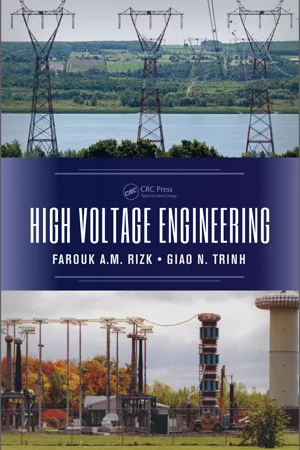
- 801 pages
- English
- ePUB (mobile friendly)
- Available on iOS & Android
High Voltage Engineering
About This Book
Inspired by a new revival of worldwide interest in extra-high-voltage (EHV) and ultra-high-voltage (UHV) transmission, High Voltage Engineering merges the latest research with the extensive experience of the best in the field to deliver a comprehensive treatment of electrical insulation systems for the next generation of utility engineers and electric power professionals. The book offers extensive coverage of the physical basis of high-voltage engineering, from insulation stress and strength to lightning attachment and protection and beyond.
Presenting information critical to the design, selection, testing, maintenance, and operation of a myriad of high-voltage power equipment, this must-have text:
-
- Discusses power system overvoltages, electric field calculation, and statistical analysis of ionization and breakdown phenomena essential for proper planning and interpretation of high-voltage tests
- Considers the breakdown of gases (SF6), liquids (insulating oil), solids, and composite materials, as well as the breakdown characteristics of long air gaps
- Describes insulation systems currently used in high-voltage engineering, including air insulation and insulators in overhead power transmission lines, gas-insulated substation (GIS) and cables, oil-paper insulation in power transformers, paper-oil insulation in high-voltage cables, and polymer insulation in cables
- Examines contemporary practices in insulation coordination in association with the International Electrotechnical Commission (IEC) definition and the latest standards
- Explores high-voltage testing and measuring techniques, from generation of test voltages to digital measuring methods
With an emphasis on handling practical situations encountered in the operation of high-voltage power equipment, High Voltage Engineering provides readers with a detailed, real-world understanding of electrical insulation systems, including the various factors affecting—and the actual means of evaluating—insulation performance and their application in the establishment of technical specifications.
Frequently asked questions
Information
Table of contents
- Cover
- Half Title
- Title Page
- Copyright Page
- Table of Contents
- Preface
- Acknowledgments
- Authors
- 1. Power System Overvoltages
- 2. Electrostatic Field Calculation
- 3. Application of Statistical Analysis in High Voltage Engineering
- 4. Electrical Breakdown in Gases
- 5. Breakdown Characteristics of Long Air Gaps
- 6. Electric Breakdown in Liquids
- 7. Electric Breakdown in Solid and Composite Materials
- 8. Selection of Overhead Transmission Line Conductors
- 9. Lightning Incidence and Lightning Protection
- 10. High-Voltage Insulators
- 11. High-Voltage (Underground) Cables
- 12. Power Transformers
- 13. Insulation Coordination
- 14. High-Voltage Testing and Measuring Techniques
- Index